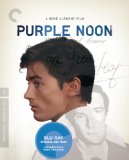| Reviews & Columns |
|
Reviews DVD TV on DVD Blu-ray 4K UHD International DVDs In Theaters Reviews by Studio Video Games Features Collector Series DVDs Easter Egg Database Interviews DVD Talk Radio Feature Articles Columns Anime Talk DVD Savant Horror DVDs The M.O.D. Squad Art House HD Talk Silent DVD
|
DVD Talk Forum |
|
|
| Resources |
|
DVD Price Search Customer Service #'s RCE Info Links |
|
Columns
|
|
|
Purple Noon: The Criterion Collection
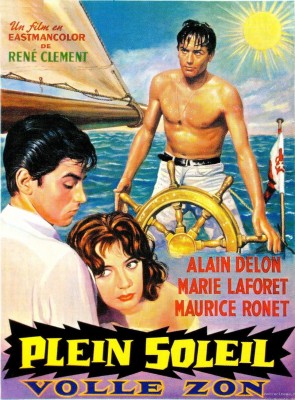
Please Note: The images used here are from stills provided by The Criterion Collection and promotional materials, and are not taken from the Blu-ray edition under review.
It starts off as postcards and lulls you, with its eye-popping, rich 'n warm views of Old-World Italy and the Mediterranean, into a wide-open tourist mode -- all the better to guide you to some truly unfamiliar and unsettling destinations. The credits of René Clément's 1960 film Purple Noon (Plein soleil) appear over still, familiar-banal images of Roman attractions (the Coliseum, etc.) submerged and fixed under bright green, purple, and yellow tints before seguing right into the action of its antihero, Tom Ripley (Alain Delon), forging the signature of his wealthy friend, Philippe Greenleaf (Maurice Ronet, Elevator to the Gallows) on the back of cheap, indistinct postcards of Rome as the sort of decadent game the two enjoy playing as they drift around Italy in idle luxury on Philippe's father's dime. Or, rather, the kind of performance the decadent alpha-male (by dint of his wealth-derived, unflappable confidence) Philippe enjoys putting his "friend" up to: Tom, we discover, has idolized Philippe and his affluent glamorousness since their school days, has always been made to feel lucky and grateful to be allowed into the sphere of people like Philippe, and is thus happy, or at least it seems, to amuse and obey Philippe in order to earn the continued privilege of his company, even to the point of thwarting the headhunting mission he's been sent on by Philippe's father, at the bounty of $5,000, to retrieve his wayward son from his never-ending Continental vacation and bring him back into the family-business fold. Tom, though it's made clear that he does not come from a wealthy family and needs the money, would rather ingratiate himself to his longtime carefree object of vaguely homoerotic envy (it's not so vague in the novel or in the 1999 film version of it, but its place as subtext, necessitated by the dominant mores of the time, doesn't substantially cloud the meaning or subvert the story here) than go the more straightforward, honest route of just earning the salary his employer has offered.
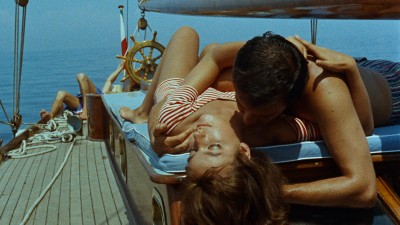
But the seemingly passive Tom, who initially seems almost to enjoy being humiliated at Philippe's snobbish, mercurially-tempered hand, means to get much more out of his voluntary ordeal as sidekick to Philippe than a measly $5,000. He is the classic scholarship kid, his personality and character formed on the lowest rung of the top section of the ladder, with direct exposure to all kinds of privilege he will never himself enjoy; those deliriously tinted vacation destinations under the opening credits could be how the charmed life of his resented betters appears in Tom's stifled, envious mind's eye. And his forged signatures across the backs of those images are much more significant than the game Philippe sees them as, too; his adroitness at forgery will, we will learn over the course of the film, be his way of imprinting and inserting himself into that life of luxury and ease. Tom is patient the way only the instinctively, expertly sycophantic can be; by being Philippe's lackey, he's set himself up in a prime spot for observing, honing his skill for written and vocal mimicry (condescendingly used as entertainment by Philippe) and absorbing Philippe's many slights into a reserve of cold vengefulness, with the methodically plotted long-term goal of parlaying his close-up study of Philippe into a total usurpation of the life he longs for, the one his friend so conspicuously and disdainfully takes for granted.
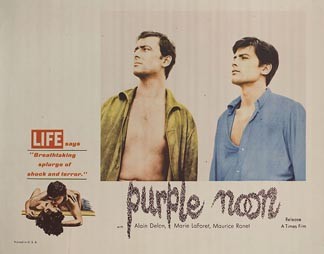
But it's one well-played trick of Clément's and of his well-chosen cohorts from the cream of the 1960s cinema crop (including frequent Claude Chabrol co-screenwriter Paul Gégoff, with whom Clément is adapting Patricia Highsmith's novel The Talented Mr. Ripley; Truffaut/Melville cinematographer Henri Decaë, and famed Fellini composer Nino Rota, whose score twinkles wickedly as the film's sinister events play out) to never let us lose sight of the postcard-life Tom wants more than anything to be let into, even as it only provides the eye-catching setting for of the hardest (and, potentially, most rewarding -- another fact Clément never lets us forget) work he's ever done in his life, weaving a sinister web that will find him striking suddenly, like an awakened scorpion, to murder Philippe while the two are playing cards on his yacht, "burying" the body at sea amid a sudden gale (in a beautifully filmed, tautly edited sequence whose visceral suspense turns the sun-drenched atmosphere nightmarish and distracts us from the fact that we're being made to helplessly plot with and root for this underdog murderer), ingeniously and meticulously taking over every aspect of his life, all while donning the guise of another of Philippe's many mourners, among whom are a supporting cast of characters Tom must either convince or eliminate: a nosy American friend, Freddy (Bill Kearns), whose correct suspicions about Tom prove fatal when he gets too close to the truth; a ballet conductress and her drunken benefactor (Elvire Popesco and Frank Latimore); and, as the film's one ray of real, pure sunlight, Philippe's art-student fiancée, Marge (the softly lovely Marie Laforêt), whose relationship with her womanizing lover has been embattled, whom we've seen pining away for him in her coastal villa while strumming lovelorn notes on her guitar as he and Tom galavant off to Rome, and who is nonetheless devastated when he goes missing, presumed dead. It really is only with Marge, whom Tom regards as just another of Philippe's accoutrements and therefore his for the taking, that we feel Tom is crossing a line; she's a poor little rich girl to be sure, but a genuine, open-hearted naïf who, though she was born into the world Tom is clawing his way into, is actually less well-suited to her ironical, spoiled, money- and privilege-saturated milieu than Tom, whose character is naturally drawn to the indolence, exclusiveness, and cruelty of those "above" him; they see the world the same way (and, though the film never gets political, who knows how much more ethical their or their families' ways to the top have been than Tom's plot?). The lonely, sad aura Laforêt casts when held in contrast to her well-appointed but uncomforting surroundings would seem to indicate that Clément had kept up on the contemporaneous L'Avventura-driven rise of Antonioni, with its rich girl's epiphany that the imposingly opulent, ancient backdrops of her life are indifferent and static in the face of personal feelings and loss. (It's in concluding on a devastating Antonioniesque visual maneuver, too, with Tom Ripley leaving the frame toward his fate and leaving us with a dazzling, impassive mountain-sea vista empty of any human presence, that the film's ending evades a sense of over-tidiness.)
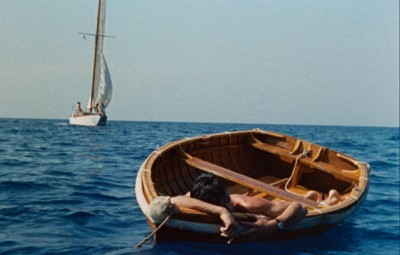
Providing a specimen of human gorgeousness to match the sunlit Roman streets and Mediterranean glow of the film's locations, the perpetually shirtless Delon, in his rich but exactingly focused performance as Tom, cuts a figure so dashingly nimble and clever, so lithely handsome and sexy, it's impossible not to admire, adore, and empathize with this "villain"; like most of the James Bonds, he's eye candy for anyone with an erotic interest in the male physique and a winning, resourceful, elegantly cool-headed role model for anyone else. Clément's filmmaking is superb (his pacing, casual mixing together of coolly Hitchcock-classical compositions/framings and handheld/on-the-street Neorealist/New-Wave sequences, with a bevy of shots simultaneously clever/striking and aptly suited to the thrilling build-up and emotional meaning of scenes making it very clear why and how Scorsese was so profoundly influenced by this film, to the point of lifting the style of one of its remarkable sequences for the street-scene Catholic pageantry that concludes Mean Streets, and theatrically re-releasing the film under his own auspices in 1996); his casting of Delon, however, is Clément's ultimate coup as a director, the one thing that might really put him -- a singular figure in French cinema, DIY documentarian, technical adviser to Cocteau on Beauty and the Beast, whose films include the likes of Gervaise and Forbidden Games, but who was nevertheless unfairly dismissed by Truffaut's prickly post-'59 generation of younger filmmakers -- in the ranks of those who followed in his Delon-casting footsteps, a laundry-list of great European directors: Visconti, Melville, Antonioni himself, Godard.
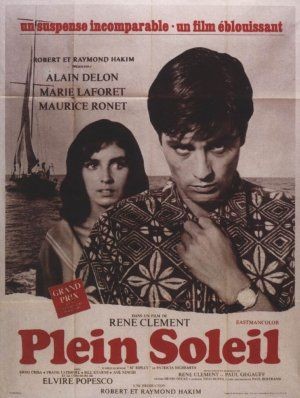
Truffaut et al. may have been right about Clément not having the personal "style" they believed would qualify a filmmaker as a bona fide auteur, but, at least in Purple Noon (and, I would say, in at least a few of his other films), his skill, individually tailored and changeable as it is from film to film, is a more than sufficient stamp of excellence, bringing the film into the sphere of Hitchcock's most confident, stealthily implicating pictures, whose disorientation and dubious, prickly moral questions are so tightly woven into the sheer exhilaration of the filmmaking that they catch you up unawares, with deeply rumbling aftershocks (were we really finding that cold-blooded killer and his 'adventures' so overwhelmingly appealing, and what does that say about our desires and the way cinema has of fulfilling them?). Indeed, Hitchcock was the first to go to his diabolical kindred spirit Highsmith's novels as source material, and his Strangers on a Train remained her favorite among the films adapted from her works (though she had high praise for Purple Noon, too); Clément is following in a master's footsteps here, while unafraid to borrow the best talent from his young detractors (Decaë had established his lensing cred with Truffaut and Louis Malle), and it would seem that the self-chosen, less self-consciously expressive, more subservient-to-the-material approach, without the heavy burden of earth-scorching, gauntlet-throwing originality shouldered by the Truffauts and the Godards, is probably what allowed their elder to make all the right choices for Purple Noon. It's not nearly as faithful to Highsmith's novel as Anthony Minghella's 1999 version with Matt Damon and Jude Law, but even though that film was easily the best of the late Minghella's filmography (generally too soggy/bloated for my taste), and appealing for its ultimate melancholy and tenderness toward Tom Ripley, Purple Noon is, like all the best film adaptations from novels, much more faithful to Highsmith's spirit than her plot specifics. The film does have more of an explicitly worried moral sense than Highsmith ever let show (Clément spotted, rather inaccurately, a touch of Dostoyevskian moral agony in Highsmith's tale and ran with it, to surprisingly good, well-integrated effect), but it's still a well-polished object whose smooth, luxe surfaces, which we can't help ourselves from eagerly reaching toward, overlie a cool-headed, eternally fascinating and troubling contemplation of just how fragile and murky are our conceptions and perceptions of good and evil, and how much further they can be complicated when confronted with the wondrous, dangerous glory of brightly-colored, sensuously ravishing moving pictures on a silver screen .
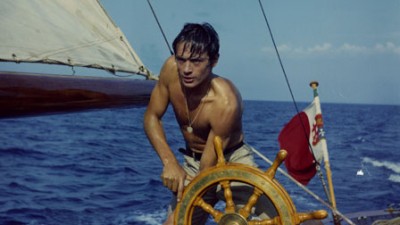
THE BLU-RAY DISC:
Henri Decaë's luscious Eastmancolor cinematography is of just the type and vintage that so often falls victim to fading and worse forms of deterioration over time. On the transfer prepared for this Blu-ray edition (AVC/MPEG-4, 1080p, preserving the original theatrical aspect ratio of 1.66:1), however, it has been restored to its full resplendency: The sea is azure, the sunlit sky deep, bright blue, and the white walls of Marge's apartment glow; overall, the near-palpability of all Decaë's colors are almost perfectly intact, and every subtle visual property (natural grain-texture included) is present and accounted for.
Sound:An uncompressed PCM 2.0 soundtrack (French, with optional English subtitles) offers our ears unfettered crystal-clear access to all dialogue, roaring winds and waves, and Nino Rota's alternately melodramatic and sinister, taunting score; every sonic element is as rich and resonant as possible while still remaining faithful to the original mono, and there's no distortion or imbalance at any point.
Extras:--A half-hour discussion of the film with Clément expert Denitza Bantcheva, who offers knowledgeable casting, preparation, and production details from the film; a subtle and complex mini-survey of Clément's work and his peculiar place in French cinema (particularly vis-à-vis the New Wave); and some incisive, acutely observant interpretation of Purple Noon, with illustrative cut-ins of the scenes under discussion.
--A 10-minute interview with Alain Delon excerpted from a 1962 French television program, in which he affably discusses his "accidental" discovery and reluctant turn to acting, his work with Visconti in The Leopard, and, most relevantly in this context, how René Clément was a rigorous director and his "professor" during his entrée to the world in front of the camera.
--A 20-minute 1971 interview with The Talented Mr. Ripley author Patricia Highsmith, also for French TV. The cigarette-smoking Highsmith presents with a cigarette-smoking, formidable, somewhat intimidating, Susan Sontag-like aura, forthrightly and with brutal honesty assaying her own skills (she doesn't adapt her own work into scripts because, she says, she has no talent for screenwriting); her bemused, half-misanthropic regard for the entire human race; and the films made from her novels (of which Hitchcock's Strangers on a Train comes before Purple Noon).
--The film's American theatrical trailer, which is both an interesting glimpse at how foreign films were marketed to American audiences at the time (sexily but not very subtly, in this instance) and, more importantly, how infinitely superior the film itself looks on this edition than the washed-out colors in the aged, non-restored trailer.
--A 40-page booklet featuring an essay by critic Geoffrey O'Brien and a reprint of a 1981 interview with René Clément.
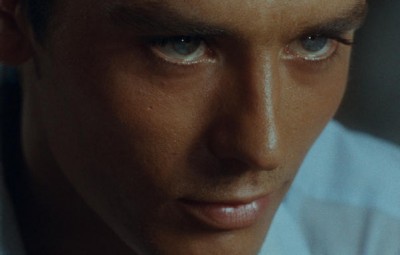
A lushly picturesque tale of identity crisis, inferiority complex, emotional tug-of-war, and disguised resentment, René Clément's Purple Noon (Plein soleil) is a paradoxical film whose particular mixture of ingredients is not quite like any other. In retelling Patricia Highsmith's lacerating, sardonic "crime" novel The Talented Mr. Ripley (adapted well enough, more faithfully, but less successfully by Anthony Minghella in 1999), with its fiendish underdog whose cleverness, resourcefulness, and boldness are as charming as they are utterly amoral, Clément draws upon implacably skilled Hitchcockian smoothness and the treacherous thematics of film noir, all while keeping up with the loose, spontaneous casualness of his younger colleagues in the French New Wave as well as Antonioni's contemporaneous use of Italian architecture (whether imposingly ancient and mysteriously, anonymously modern) and seascapes as the beautiful but indifferent backdrop of idle-rich drifting and ennui. The result is something uniquely unsettling, a murder-mystery in which the murderer is really the sympathetic, "relatable" one, with his dark machinations played out for our riveted delectation under a cloudless, idyllic Mediterranean sky -- a seductive nightmare in broad daylight. It's as ravishing, entertaining, and aesthetically/narratively skilled as you could hope for, with a career-making star turn by the impossibly beautiful Alain Delon that will surely captivate and/or arouse anyone who lays eyes on it until the end of time. But all that only baits Clément's trap, luring us right into his devilish plot to discombobulate and implicate us in the doings of this gorgeous, ambitious cipher as he gets the better of the complacent (though, easy enough to forget, innocent) enemies who inhabit an upper crust that beckons yet remains cruelly closed to him. It's almost as if Psycho had been set amid jet-setting Continental luxury and we'd seen the whole thing play out mostly from the POV of that poor, appealing, misunderstood Norman Bates, who just got sick of being looked down on and decided to murder his way out of his conundrum. This way Purple Noon has of turning its world and characters upside down and the wrong way round feels so light and effortless, is so skillfully seductive, as to seem almost actually dangerous upon reflection -- a danger that comes in no small part from how little difference there appears to be between the upside-down world it presents and the one we accept, in life and in films, as right-side-up, making it easy enough to believe that, like Tom Ripley stealing Philippe Greenleaf's identity, one could stand in for the other, and few would really notice. Highly Recommended.
|
| Popular Reviews |
| Sponsored Links |
|
|
| Sponsored Links |
|
|
| Release List | Reviews | Shop | Newsletter | Forum | DVD Giveaways | Blu-Ray | Advertise |
|
Copyright 2024 DVDTalk.com All Rights Reserved. Legal Info, Privacy Policy, Terms of Use,
Manage Preferences,
Your Privacy Choices | |||||||









